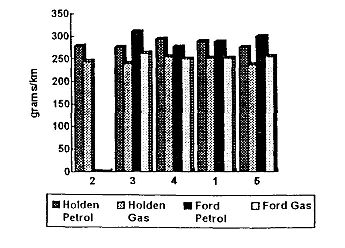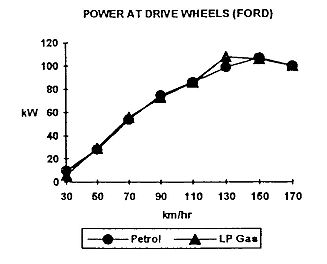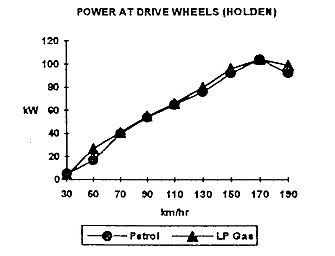From RROCA-info
LPG and Rolls-Royce
by John Edwards (NSW), October, 1999
Did you know that Rolls-Royce motors are run on LPG on the test bench at Crewe because it is a cleaner running fuel? I was told this by Dave Thomas who was once the trouble shooter for Crewe with dealers throughout Britain.
I know of three other Shadows fitted with LPG. Two are wedding cars and the other is owned by member Tony Richardson, a very experienced motor mechanic who is very enthusiastic about LPG - as am I.
When I became the proud fourth owner of SRH16549, in 1990, I was assured by the late Bruce Ross that the 75627 miles on the clock were genuine.
The Gas Man at Kensington, Sydney (now at Alexandria, Sydney) fitted an Impco LPG system for me at 85,800 miles. Since then I have clocked up just on a further 108,000 miles without any problems from the LPG system. Less than 4000 of these miles were on petrol. Because of too little use, my SU petrol pumps packed it in on the lonely stretch in western NSW between Hay and Balranald but I simply switched back to LPG and went happily on my way. The NRMA man at Balranald advised me to do about a hundred miles in each thousand on petrol to keep that system in good working order. According to him the points in the SU pump build up plaque if not used, causing them to overheat and cut out. Since taking this competent man's advice I have had no further problems with the SU pumps.
Starting the motor Until recently I always switched back to petrol for the first start of the day to achieve instant firing. Because the motor had to suck LPG from the tank it took seven or eight revolutions before firing occurred. Tony Richardson introduced me to Tony Schott at Gaspower Automotive Services of Warners Bay near Newcastle who had done two R-R LPG conversions for him. Tony Schott fitted a Fast Start Valve to my LPG system and I can now get instant firing from either fuel. Incidentally, the system fitted by Schott is much more compact than the Impco system fitted to my car and has given "Richo" no trouble on the two Shadows he had it fitted to.
Power
There is no noticeable difference in power between LPG and petrol except on really steep climbs of about 1 in 6 or less - one does not encounter many of these. On my test hills either side of the Mooney bridge along the Newcastle expressway the Shadow will gain speed on either fuel if asked. Because LPG runs a few degrees hotter than petrol it helps to switch back to petrol for long climbs on very hot days e.g. Mount Ousley near Wollongong.
Economy
Fuel consumption is higher on LPG than petrol but this is very well compensated by the lower cost of LPG, usually half the price of petrol or less. The cost saving on LPG against petrol is about 40% for the way I drive and the mileages I do. It is my policy to drive at or below the speed limit. As a means of monitoring engine performance and getting early warning of potential problems, I have always logged petrol consumption on every car I have owned.
The following fuel figures are averaged over the 108,000 miles done since LPG was fitted. Petrol figures in brackets.
- CITY - 11 mpg (12)
- TOURING at 100-110 kph - 13mpg (16)
- TOURING at 80 kph - 14.3mpg (11)
A run I have done many times, from coastal Sydney to Bowral in the Southern Highlands, gives a good idea of LPG mileage uphill versus downhill. On the return journey the mileage has consistently been 3mpg better. So don't go there - just come back!
Range
The LPG tank is in the boot and the biggest tank I could fit between the wheel arches was 54 litre, of which 52 litres can be used. This gives an effective range of 140 to 150 miles. A much bigger tank can be fitted where loss of half the boot space is not a problem. The enforced break to refuel every couple of hours or so can be considered a safety factor against fatigue, especially for those in my age bracket.
Engine wear due to LPG
None apparent. Due to a wrong diagnosis of the cause of water loss, the heads were taken off the engine at 127,000 miles, i.e. 42,000 miles after LPG was fitted. The engineer who checked the head, and ground the valves (I replaced from another cause) commented that there was no damage from using LPG but the engine was much cleaner than he would have expected had petrol been the main fuel. Oil consumption has hardly varied in the last 50,000 miles and actually decreased before then after I changed to a special oil called Tough Country Super that I buy direct from the Brisbane manufacturer. This oil also makes the engine run quieter.
General Comments
The Gas Man charged $2,000 to fit the Impco system in 1990 and told me that it would cost "more" to convert the next Shadow if it had Cruise Control because of having to fiddle about the obstructive diaphragm of the Cruise Control. There was no Cruise Control (sorry R-R, you call it Speed Control) on the earlier Shadow he converted. The much less cumbersome system fitted by Tony Schott would not have this problem. Probably the best recommendation I can give Tony is to tell readers that I regard him as the John Vawser of Gas. Anyone thinking of converting to LPG would have nothing to lose by talking to Tony on 02 4956 6041.
There is a switch out of sight under the dash for changing from one fuel to the other. If this switch is placed in the neutral position when leaving the car, the motor will start on the small amount of fuel left and then cut out. This gives some measure of protection from a thief who does not realise that the car is dual fuel. LPG is so readily available that the only stretch where I need to rely on petrol for a short distance is between Hay and Balranald when going to Adelaide. Victoria is no problem at all nor is Queensland up to Noosa, which is the furthest I have been. Booklets are available from service stations showing where LPG is available throughout Australia. I understand that LPG causes less pollution than petrol.
I can thoroughly recommend LPG as a safe, reliable & economical fuel.
John Edwards
Converting To LP Gas
By Tony Ward (NSW), September 1999
In answer to a member's request for the "pros and cons" of changing to LP gas, here is the bulk of an article published by the Australian Liquefied Petroleum Gas Association and supplied by the NRMA Technical Library.
What is LP Gas?
Liquefied Petroleum Gas (LP Gas), like petrol, is a hydrocarbon fuel. It is mainly composed of propane and butane with a minor amount of propylene. LP Gas in its normal state is a vapour, but when moderately compressed, it becomes a liquid. This enables a vehicle with a full LP Gas cylinder to travel a similar distance as the same vehicle would travel on an equal amount of petrol. The technical specification of LP Gas for automotive use is controlled to ensure consistent vehicle performance with clean, smooth combustion under all driving conditions. LP Gas is non toxic, non corrosive, free of lead and heavier than air. LP Gas in its basic state is both colourless and odourless. To alert people when there is a gas leak, an odourant with a distinctive smell is added at the time of production.
Where does LP Gas come from?
There are two sources of supply:
- Naturally occurring LP Gas which is gas that has been extracted from oil and/or gas fields in various areas of Australia. There are four main areas:
- Bass Strait in Victoria
- Cooper Basin in South Australia
- The Northwest Shelf in Western Australia
- The Surat Basin in Queensland
- Refinery Production. In Australia there is refinery production of LP Gas in all mainland States - one refinery in Western Australia, one in South Australia, two in Victoria, two in New South Wales and two in Queensland. In 1992 approximately 16% of total production came from the refineries. In 1996 22% of total production came from refineries.
Is autogas available in remote country areas?
Autogas marketers have made a major commitment in recent years to the establishment of nation wide retail network of autogas outlets. It is now possible to travel very comfortably to all locations in Australia utilising autogas.
A number of publications are available from LP Gas merchants or book shops which detail available outlets in each State and their opening and closing times.
Is LP Gas safe?
All use of LP Gas in vehicles is controlled by State Government Regulations and National Codes. The components associated with the LP Gas fuel system are manufactured and then fitted to extremely strict standards. There is substantial practical evidence to confirm that LP Gas fuelled vehicles are as safe, if not safer than petrol fuelled vehicles. Ask yourself the question: Do I prefer to have a vehicle that has a plastic tank full of petrol or a vehicle that has a 3mm thick steel cylinder full of LP Gas parked in my garage?
In all States and Territories motor mechanics must hold an additional licence (involving further training) to allow them to install and/or repair LP Gas components.
Is LP Gas environmentally friendly?
The use of LP Gas has a positive impact on both the urban and global environmental problems Australia faces.
Combustion of autogas results in less, and in some cases none, of the following harmful emissions:
- carbon monoxide
- methane
- sulphur dioxide
- low level ozone
- unburned hydrocarbons
- oxides of nitrogen
- particulates
LP Gas also reduces greenhouse gas emissions. Tests conducted on a number of Holden Commodores and Ford Falcons by ALPGA to Australian Standard 2077 and ADR 37/00 requirements produced results which had very low exhaust emissions when the vehicles were fuelled with LP Gas compared with when they were fuelled with unleaded petrol (ULP).
The study showed that if a modern ULP fuel injected engine fitted with a 'closed loop' engine management system was converted to LP Gas operation and fitted with an LP Gas 'closed loop' management system, it would reduce exhaust gas emissions by:
- An average 62% reduction in emissions of Carbon Monoxide compared to the limits set by ADR 37/00 for production vehicles.
- An average 83% reduction in emission of hydrocarbons compared to the limits set by ADR 37/00 for production vehicles.
- An average 65% reduction in emissions of oxides of nitrogen compared to the limits set by ADR 37/00 for production vehicles.
When the LP Gas emissions results are compared to unleaded petrol (ULP) the average values of HC and NOX are lower for LP Gas with a 34% reduction in oxides of nitrogen and a 13.33% reduction in carbon dioxide.
The use of LP Gas reduces evaporative emissions of HC virtually to zero (due to being a sealed system) not only from the vehicle's cylinder but also during refuelling, transport and handling of the fuel.
Carbon Dioxide (CO2) is one of the main contributors to greenhouse gas emissions. The table (right) displays the results obtained from all the tested vehicles.
What makes up an LP Gas system?
- LP GAS FILL POINT
- Connection for the LP Gas fuel dispensing bowser. It takes no more time to fill an LP Gas container than a tank for other vehicle fuels.
- LP GAS CONTAINER
- A pressure vessel made of high quality steel and constructed to comply with AS 3509. Incorporates various safety devices including:
- Automatic fill limiters restrict filling to 80% of cylinder capacity to allow for liquid expansion.
- The safety valve limits any pressure increase to well within safety specifications.
- Manually operated cylinder shut off valve used to shut off fuel from container to under bonnet components.
- Excess flow valves designed to stop flow of liquid from the container in the event of a cylinder valve shear off.
- Electric solenoid operated shut off valve designed to completely shut off LP Gas liquid flow from the cylinder in the event of a broken fuel line and/or engine shut down.
- FUEL LOCK
- Allows fuel to flow to the engine only when the engine is functioning.
- CONVERTOR/REGULATOR
- Reduces LP Gas pressure allowing liquid LP Gas to change into a vapour, then regulates how much LP Gas vapour the engine requires as engine load increases.
- GAS AND AIR MIXER
- Mixes LP Gas fuel vapour with incoming air for combustion.
- LP GAS FUEL CONTROL PROCESSOR
- Operates in conjunction with vehicle manufacturer's on-board computer to accurately meter fuel. Complies with emission standards set by Governments. Increases fuel economy and engine flexibility.
Is much of the vehicle's manufacturer's equipment altered?
Vehicle manufacturers are compelled to construct vehicles and engine management systems that meet strict Federal Government and State Environmental Protection Authorities requirements. Consequently when a vehicle is converted to operate on LP Gas these guidelines and requirements must be maintained. This is achieved by the fitment of LP Gas components that complement the original equipment fitted to the vehicle.
Should conversions be dual-fuel or gas only?
Modern day fuel injected engines limit for Unleaded Petrol (ULP) and comprising the latest engine management systems lend themselves to be converted to dual-fuel operation, giving excellent results in both fuel modes. The LP Gas equipment has been developed to tap into the vehicle's engine management system so as to give similar engine performance whether driven in LP Gas mode or petrol mode.
There has always been a belief that when an engine is converted to LP Gas usage it will suffer a reduction in power and torque. This may have been the case in pre ULP fuel injected engines which had cylinder heads, combustion chambers, induction ports and inlet tracts designed for petrol carburettor fed engines.
However, the advent of ULP fuel injected engines has allowed a complete rethink and redesign of components which were part of the cause of loss in engine power when fuelled with LP Gas (eg larger valves, tuned inlet tract tubes, large plenum chambers etc).
The following graphs display and compare engine performance results obtained from a Holden Commodore V6 and a Ford Falcon 6 cylinder when using LP Gas and then ULP.
As can be seen in the above graphs, engine performance was not compromised on either fuel.
Does LP Gas have an effect on engine wear?
An appreciable reduction in overall engine wear is normal. This is particularly applicable during cold starting because LP Gas does not wash lubricating oil from the cylinder walls. Modern unleaded petrol engines are especially suitable for conversion to LP Gas.
Can a reconditioned engine be converted satisfactorily?
A new or reconditioned engine should be run-in on petrol for approximately 3000 km and then switched over to LP Gas operation. A new vehicle can be converted at time of purchase to dual-fuel operation but the engine should be run-in on petrol then switched to LP Gas operation.
Does conversion alter insurance or registration costs?
In all States the major insurance companies do not impose an extra premium or penalty for LP Gas fuelled vehicles. This further confirms the inherent safety of conversions. Your insurance company and relevant Government Transport departments should be notified immediately after LP Gas installation to ensure that records are updated.
Are local garages competent to tune converted vehicles?
No, because in all states only authorised or licensed LP Gas installers may work on LP Gas vehicle systems. Motorists are advised to take any problems involving operation on LP Gas to any ALPGA accredited LP Gas conversion workshop. If the matter appears to involve only the petrol mode on a Dual Fuel conversion, it is still advisable to check first with an LP Gas conversion workshop. Automotive LP Gas installers are also qualified motor mechanics.
On what basis do you choose the installer?
LP Gas conversion work should be undertaken only by experienced companies with authorised staff, possessing the equipment to properly fit and tune the vehicle. Cheap conversions may initially seem attractive but any savings are certain to be taken up in increased running costs and poor overall performance. Correctly installed LP Gas components, which are installed by specialists and tuned correctly, will provide trouble free performance with assured after sales support.
ALPGA Accredited Automotive LP Gas Installers are attentive to customers' interests and provide quality workmanship and service. Look for this sign before authorising any LP Gas work on your car.
Tony Ward



